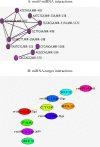Celiac disease and hepatitis C relationships in transcriptional regulatory networks
- PMID: 29379596
- PMCID: PMC5758739
Celiac disease and hepatitis C relationships in transcriptional regulatory networks
Abstract
Aim: we mainly aimed to elucidate potential comorbidities between celiac disease and hepatitis c by means of data and network analysis approaches.
Background: understanding the association among the disorders evidently has important impact on the diagnosis and therapeutic approaches. Celiac disease is the most challenging, common types of autoimmune disorders. On the other hand, hepatitis c virus genome products like some proteins are supposed to be resemble to gliadin types that in turn activates gluten intolerance in people with inclined to gluten susceptibilities. Moreover, a firm support of association between chronic hepatitis and celiac disease remains largely unclear. Henceforth exploring cross-talk among these diseases will apparently lead to the promising discoveries concerning important genes and regulators.
Methods: 321 and 1032 genes associated with celiac disease and hepatitis c retrieved from DisGeNET were subjected to build a gene regulatory network. Afterward a network-driven integrative analysis was performed to exploring prognosticates genes and related pathways.
Results: 105 common genes between these diseases included 11 transcription factors were identified as hallmark molecules where by further screening enriched in biological GO terms and pathways chiefly in immune systems and signaling pathways such as chemokines, cytokines and interleukins.
Conclusion: in silico data analysis approaches indicated that the identified selected combinations of genes covered a wide range of known functions triggering the inflammation implicated in these diseases.
Keywords: celiac disease; hepatitis c; regulatory network.
Conflict of interest statement
The authors declare that they have no conflict of interest.
Figures





Similar articles
-
Network Analysis of Common Genes and Transcriptional Factors between Celiac Disease and Inflammatory Bowel Diseases.Middle East J Dig Dis. 2020 Oct;12(4):257-264. doi: 10.34172/mejdd.2020.191. Middle East J Dig Dis. 2020. PMID: 33564383 Free PMC article.
-
The prevalence of celiac autoantibodies in hepatitis patients.Iran J Allergy Asthma Immunol. 2010 Sep;9(3):157-62. Iran J Allergy Asthma Immunol. 2010. PMID: 20952805
-
High prevalence of gluten sensitivity in a cohort of patients with undifferentiated connective tissue disease.Eur Ann Allergy Clin Immunol. 2015 Mar;47(2):54-7. Eur Ann Allergy Clin Immunol. 2015. PMID: 25781195
-
Association between celiac disease and chronic hepatitis C.Gastroenterol Hepatol Bed Bench. 2016 Summer;9(3):153-7. Gastroenterol Hepatol Bed Bench. 2016. PMID: 27458507 Free PMC article. Review.
-
Liver dysfunction in celiac disease.Minerva Med. 2008 Dec;99(6):619-29. Minerva Med. 2008. PMID: 19034259 Review.
Cited by
-
Comparison of cytokine and gene activities in tissue and blood samples of patients with celiac disease.Gastroenterol Hepatol Bed Bench. 2019;12(Suppl1):S108-S116. Gastroenterol Hepatol Bed Bench. 2019. PMID: 32099610 Free PMC article.
-
Introducing tumor necrosis factor as a prominent player in celiac disease and type 1 diabetes mellitus.Gastroenterol Hepatol Bed Bench. 2019;12(Suppl1):S123-S129. Gastroenterol Hepatol Bed Bench. 2019. PMID: 32099612 Free PMC article.
-
Network Analysis of Common Genes and Transcriptional Factors between Celiac Disease and Inflammatory Bowel Diseases.Middle East J Dig Dis. 2020 Oct;12(4):257-264. doi: 10.34172/mejdd.2020.191. Middle East J Dig Dis. 2020. PMID: 33564383 Free PMC article.
-
Screening of Altered Metabolites and Metabolic Pathways in Celiac Disease Using NMR Spectroscopy.Biomed Res Int. 2021 Nov 15;2021:1798783. doi: 10.1155/2021/1798783. eCollection 2021. Biomed Res Int. 2021. PMID: 34820452 Free PMC article.
-
The Role of Viruses in the Pathogenesis of Immune-Mediated Gastro-Intestinal Diseases.Int J Mol Sci. 2024 Jul 30;25(15):8301. doi: 10.3390/ijms25158301. Int J Mol Sci. 2024. PMID: 39125870 Free PMC article. Review.
References
-
- Ehsani-Ardakani MJ, Rostami Nejad M, Villanacci V, Volta U, Manenti S, Caio G, et al. Gastrointestinal and non-gastrointestinal presentation in patients with celiac disease. Arch Iran Med. 2013;16:78–82. - PubMed
-
- Rostami-Nejad M, Villanacci V, Hogg-Kollars S, Volta U, Manenti S, Reza-Zali M, et al. Endoscopic and histological pitfalls in the diagnosis of celiac disease: A multicentre study assessing the current practice. Rev Esp Enferm Dig. 2013;105:326–33. - PubMed
-
- Lindenbach BD, Rice CM. Unravelling hepatitis C virus replication from genome to function. Nature. 2005;436:933–8. - PubMed
-
- Mengshol JA, Golden-Mason L, Rosen HR. Mechanisms of Disease: HCV-induced liver injury. Nat Clin Pract Gastroenterol Hepatol. 2007;4:622–34. - PubMed
-
- Gale M Jr, Foy EM. Evasion of intracellular host defence by hepatitis C virus. Nature. 2005;436:939–45. - PubMed
LinkOut - more resources
Full Text Sources
